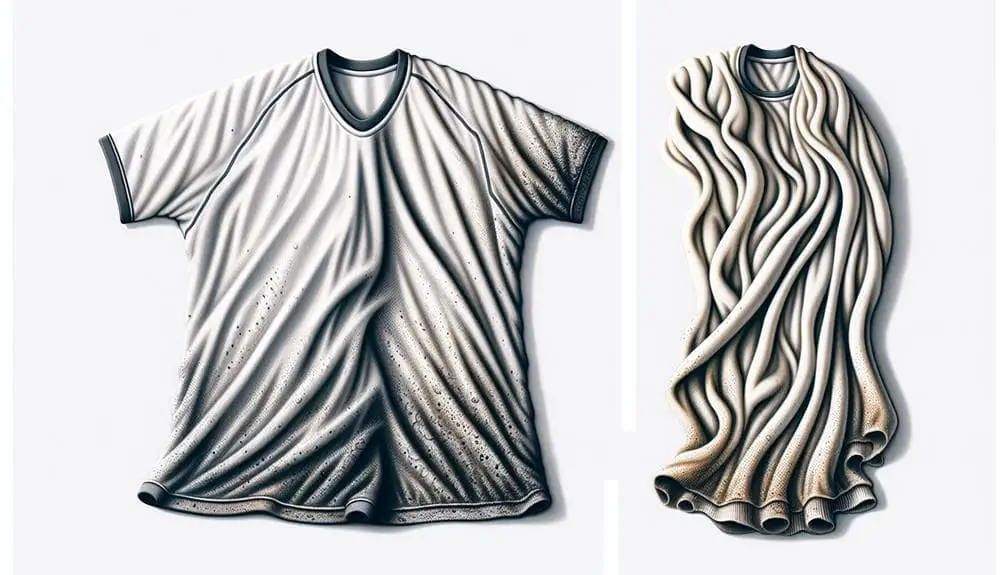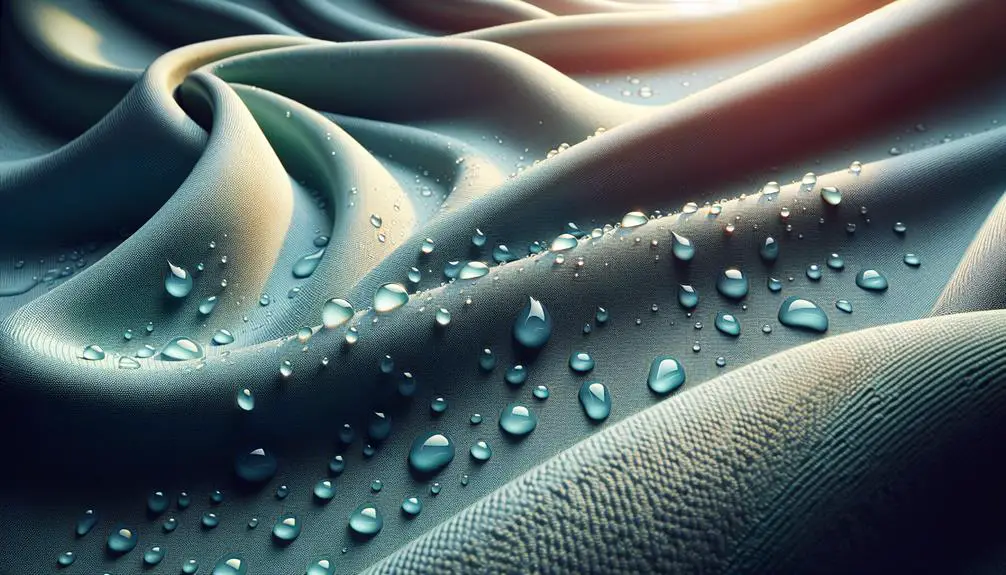To maintain moisture-wicking fabrics, proper care is essential. Washing in cold water with gentle detergent is vital. Avoid fabric softeners and air dry to maintain effectiveness. If machine-drying, use low heat and add a dry towel. Storing in a cool, dry place keeps them performing. These practices guarantee fabrics efficiently manage moisture, keep you dry, and last longer.
Key Points
- Enhances fabric longevity by preserving technical fibers.
- Improves odor control capabilities for long-lasting freshness.
- Efficiently manages moisture to keep you dry and comfortable.
- Retains sweat-wicking properties over time with proper care.
- Prevents shrinkage and maintains moisture-wicking capabilities with correct washing and drying techniques.
Benefits of Maintaining Moisture-Wicking Fabrics
Understanding the benefits of properly maintaining moisture-wicking fabrics can greatly enhance the performance and longevity of your activewear. These fabrics are designed to efficiently manage moisture, ensuring ideal sweat absorption during physical activities. By maintaining them correctly, you not only prolong their fabric longevity but also enhance their odor control capabilities.
Moisture-wicking fabrics excel in wicking away sweat from your skin, keeping you dry and comfortable during intense workouts. Proper maintenance ensures that these fabrics retain their sweat-wicking properties over time, allowing you to perform at your best without discomfort. Additionally, maintaining these fabrics as recommended can notably improve their odor control features, keeping your activewear fresh and odor-free even after prolonged use.
To maximize the benefits of moisture-wicking fabrics, it's essential to adhere to proper maintenance practices. By doing so, you not only enhance the comfort levels of your activewear but also prolong its durability and functionality.
Washing Instructions for Moisture-Wicking Shirts
For essential care of your moisture-wicking shirts, follow these precise washing instructions to uphold their performance and durability.
- Machine Wash Cold: Use a gentle cycle with cold water to prevent damage to the fabric and maintain its moisture-wicking properties.
- Gentle Detergent: Opt for a detergent specifically formulated for activewear to preserve the technical fibers and guarantee proper moisture-wicking functionality.
- Avoid Fabric Softeners: Fabric softeners can leave a residue on moisture-wicking fabrics, reducing their ability to wick away moisture effectively.
- Air Dry: Hang your moisture-wicking shirts to air dry instead of using a dryer to prevent shrinkage and prolong fabric longevity.
Following these meticulous washing instructions will help you properly care for your moisture-wicking shirts, ensuring they continue to perform at their best and last longer.
Maintaining the integrity of the fabric through correct washing techniques is vital for preserving its moisture-wicking properties and overall quality.
Drying Techniques for Moisture-Wicking Fabrics
To effectively preserve the moisture-wicking properties of your fabrics, employ proper drying techniques following the washing process. After washing your moisture-wicking garments, the next essential step is to make sure they're dried correctly.
Air drying is one of the best methods for maintaining the fabric's moisture-wicking capabilities. Hang your garments in a well-ventilated area away from direct sunlight. This allows for natural airflow, aiding in the evaporation of moisture without compromising the fabric's technology.
If you need your moisture-wicking apparel to dry quickly, consider using a dryer on a low heat setting. However, avoid using high heat as it can damage the fabric and affect its moisture-wicking abilities. Always refer to the garment's care instructions to confirm it's safe for machine drying.
To expedite the drying process further, you can add a dry towel to the dryer to help absorb excess moisture. By following these techniques, you can maintain the effectiveness of your moisture-wicking fabrics and ensure they last longer.
Storing Tips for Moisture-Wicking Apparel
Proper storage of moisture-wicking apparel is vital to maintaining their performance and longevity. To guarantee your moisture-wicking garments remain in top condition, follow these expert tips:
- Storage solutions: Store your moisture-wicking apparel in a cool, dry place away from direct sunlight. Avoid storing them in plastic bags or airtight containers, as this can trap moisture and lead to mold or mildew growth.
- Fabric care: Before storing, make certain your moisture-wicking garments are completely dry to prevent any musty odors or mildew. Ensure they're folded neatly to prevent creases that could damage the fabric over time.
- Air circulation: Allow for adequate air circulation in the storage area to prevent moisture buildup. Consider using breathable garment bags or hanging storage solutions to keep your apparel fresh.
- Separate storage: Keep your moisture-wicking apparel separate from other clothing items to prevent any transfer of odors or potential damage from zippers or buttons.
Common Mistakes in Caring for Moisture-Wicking Garments
Mistakes commonly made when caring for moisture-wicking garments can greatly impact their performance and lifespan. One common error is using fabric softeners or dryer sheets, as these leave residues that clog the fabric's pores, reducing its moisture-wicking ability. Additionally, washing these garments in hot water can break down the fabric's moisture-wicking properties over time. Improper storage is another pitfall to avoid. Storing moisture-wicking apparel in damp or humid conditions can promote mold and mildew growth, compromising both the fabric's longevity and its moisture-wicking capabilities.
Moreover, using too much detergent can leave a residue that hinders the fabric's ability to wick moisture effectively. It's important to follow the manufacturer's guidelines regarding the amount of detergent to use. Finally, avoid using bleach on moisture-wicking garments as it can weaken the fabric fibers, leading to quicker deterioration. By steering clear of these common mistakes and following proper care instructions, you can guarantee that your moisture-wicking garments maintain their performance and longevity.
Frequently Asked Questions
Can Moisture-Wicking Fabrics Lose Their Effectiveness Over Time if Not Properly Maintained?
Without proper maintenance, moisture-wicking fabrics can lose effectiveness over time. Long term effects include decreased performance and durability. Regular care, like gentle washing and avoiding fabric softeners, preserves their moisture-wicking properties.
Are There Specific Detergents or Fabric Softeners That Should Be Avoided When Washing Moisture-Wicking Garments?
When caring for moisture-wicking fabrics, select gentle detergents designed for sportswear to maintain their performance. Avoid fabric softeners as they can clog the fabric's pores, diminishing its moisture-wicking abilities over time. Follow these fabric care tips diligently.
How Often Should Moisture-Wicking Shirts Be Washed to Maintain Their Performance?
To sustain peak performance and longevity of moisture-wicking shirts, wash them after each use. Regular washing eliminates sweat and oils that can impede moisture-wicking capabilities. Correct care guarantees the fabric functions efficiently and lasts longer.
Can Using High Heat Settings in the Dryer Damage Moisture-Wicking Fabrics?
Using high heat settings in the dryer can potentially damage moisture-wicking fabrics. The intense heat can impact the fabric's performance by breaking down its moisture-wicking properties. To maintain fabric care and performance, opt for low-heat drying settings.
Are There Any Special Considerations for Storing Moisture-Wicking Apparel in Humid Environments?
Like a ship needs a sturdy anchor, proper storage for moisture-wicking apparel in humid environments is essential. Maintain humidity control to prevent mold and mildew growth. Store in well-ventilated areas away from direct sunlight for longevity.


